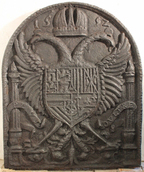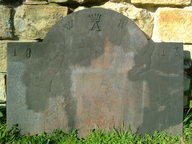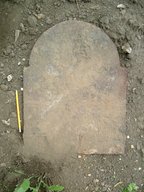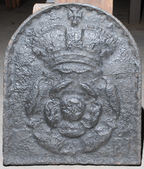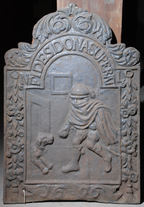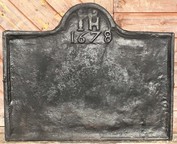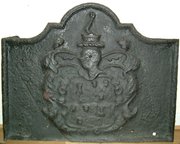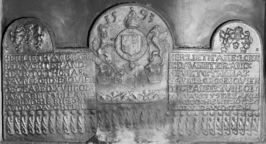-
627
Description: Arched shape; cavetto moulded edge; double-headed eagle displayed, a Holy Roman Imperial crown above; in front, a quartered shield; a flaming pillar on each side, a motto scroll entwining each.
Notes: The shield bears the arms of Charles V, Holy Roman Emperor (reigned 1519-1556), king of Spain and nephew of Katherine of Aragon, Queen of England; the pillars are a symbolic representation of the Pillars of Hercules at the Strait of Gibraltar. Some variants of this fireback have a different date (e.g. see no. 1267) or none at all.
Copies of this fireback are known.
Inscription: PLVS OVLTRE [Further Beyond]
Arms: Charles V, Holy Roman Emperor
- Decoration tags:
- rounded arched (shape)
- cavetto (edging)
- whole carved pattern
- individual numbers
- heraldic
- armorial
- royal
- text
Manufactured: in 1592 possibly in the Eifel area of Germany.
Current location: Ashbourne, Derbyshire, England.
- Attached to series:
- Foreign armorial firebacks
-
14
Description: Arched rectangular shape; plain plate. Crowned capital ‘A’ between ‘W’ and ‘R’; divided date at top extremities of plate; single six-pointed star below ‘A’.
Notes: Earl’s coronet denotes the Earl of Ashburnham, furnace owner; ‘WR’ denotes William Rummins, furnace founder; 1813 - the furnace was blown out for the last time in late February 1813. Similar to, but narrower than the fireback at Church Farm, Penhurst (in private hands), and uses the same cipher and numbers. One of a small series of firebacks cast in the early-19th century for farms on the Ashburnham estate; this example was formerly at Great Sprays Farm, Penhurst.
Inscription: W A R / 18 * 13
- Decoration tags:
- rectangular with round arch (shape)
- none (edging)
- carved stamps
- individual letters
- individual numbers
- heraldic
- text
- objects
Manufactured: in 1813 at Ashburnham Furnace in the Weald area of England.
Current location: in private hands, Ashburnham, East Sussex, England.
- Attached to series:
- Ashburnham late series
-
15
Description: Arched rectangular shape; no edging.
Notes: The plain form suggests a common source with firebacks cast at Ashburnham in 1813. One of a small series of firebacks cast in the early-19th century for farms on the Ashburnham estate.
- Decoration tags:
- rectangular with round arch (shape)
- none (edging)
Manufactured: in the early-19th century probably at Ashburnham Furnace in the Weald area of England.
Current location: in private hands, Ashburnham, East Sussex, England.
- Attached to series:
- Ashburnham late series
- Base boards
-
849
Description: Rectangular with superimposed arch; embattled, cavetto moulded edging, with the top edge of the rectangle interrupted; shield, garter, crown, supporters and motto of the English Royal house of Stuart; rose and thistle plants above lion and unicorn supporters respectively; initials split by crown; date below garter.
Notes: A version dated 1619 is proportioned slightly differently and has smaller rose and thistle plant stamps.
Copies of this fireback are known.
Inscription: I R / 16 21
Arms: English Stuart royal - James I
- Decoration tags:
- rectangular with round arch (shape)
- embattled cavetto (edging)
- whole carved pattern
- armorial
- royal
- text
Manufactured: in 1621 in England.
Current location: in private hands, Ashurst, West Sussex, England.
-
842
Description: Arched shape; cavetto-moulded edging invected on the inner edge; Tudor rose surmounted by a royal crown; monogram in bottom right corner.
Notes: The monogram, RN, is associated with the invected cavetto moulding; a recasting, replicating an earlier crack.
Inscription: RN
- Decoration tags:
- rounded arched (shape)
- scalloped cavetto (edging)
- whole carved pattern
- heraldic
- monogram
- royal
- text
Manufactured: in the early- to mid-17th century in England.
Current location: English Heritage Store, Atcham Business Park, Atcham, Shropshire, England.
Museum number: EH ASC 4490 (part of the English Heritage museum group)
- Attached to series:
- RN series
- Miscellaneous royal firebacks
-
844
Description: Arched rectangular central panel; fillet edging; pictorial scene of a cloaked figure, to the right, tempting a dog, to the left, with a tasty morsel; behind are the outlines of a door and window; arched rectangular border with fillet edging, the date along the bottom; down each side, a floral festoon; over the arch, the inscription, the initials split between each side of the main inscription; on top, floral scrolls.
Notes: The inscription translates as 'loyalty above gifts'; some castings omit the initials, NL, indicating that they were a subsequent addition. The illustration is derived from 'The thief and the dog', one of a series of engravings of Aesop's Fables by Wenceslaus Hollar.
Copies of this fireback are known.
Inscription: N / FIDES DONA SUPERAT / L // 1696
- Decoration tags:
- 'Dutch' (shape)
- fillet (edging)
- whole carved pattern
- individual letters
- planklines
- pictorial
- allegorical
- text
- animals
- humans
Manufactured: in 1696 possibly in the Siegerland area of Germany.
Current location: English Heritage Store, Atcham Business Park, Atcham, Shropshire, England.
Museum number: EH ASC 4491 (part of the English Heritage museum group)
- Attached to series:
- 'Dutch' 1696 NL series
-
603
Description: Arched rectangular shaped, the arch linked to the rectangle by cavetto curves; cavetto edging ending in two opposed spirals at top; initials below spirals; date below initials; otherwise plain.
Notes: Probably cast from a carved, edged board, with the initials and date added separately. A copy.
Copies of this fireback are known.
Inscription: IH / 1678
- Decoration tags:
- rectangular with round arch (shape)
- cavetto (edging)
- individual letters
- individual numbers
- text
Manufactured: in 1678 in the Weald area of England.
Current location: Banbury, Oxfordshire, England.
- Attached to series:
- Small arch series
-
1319
Description: Rectangular with pediment raised on inverted consoles; fillet edging, ovolo-moulded in the pediment; shield, garter, helm, mantling, crest of a lion surmounting a chapeau, and motto cartouche with obliterated text; on each side, an extension panel with a vertical guilloche pattern.
Notes: One of several firebacks, all varying in size, framing style and moulding, with stylistic features in common and almost certainly the work of the same pattern maker, who was also responsible for carving royal coats of arms in several West Country churches. The presence of the chapeau, or Cap of Maintenance, is unusual on arms of this period, it being more common on medieval achievements.
Copies of this fireback are known.
Arms: English Stuart royal
- Decoration tags:
- rectangular with detached pediment (shape)
- fillet (edging)
- whole carved pattern
- extension panels
- heraldic
- armorial
- royal
Manufactured: in the early-17th century in England.
Current location: Barnstaple Guildhall, Butchers Row, Barnstaple, Devon, England.
- Attached to series:
- Bristol armorial group
- Stuart royal armorial firebacks
-
16
Description: Arched rectangular shape cut away with symmetrical concave curves; ovolo moulding (top and sides); shield, helmet, crest and mantling of the family of Baker, of Mayfield, quartered with Farnden, of Sedlescombe: Quarterly, 1st and 4th, Argent, a tower between three keys erect sable (Baker); 2nd and 3rd, Purpure, a chevron vairy Or and gules, between three leopards’ faces Or (Farnden). Crest (Baker): on a tower sable an arm embowed in mail holding in the hand a flint-stone proper.
Notes: A carved armorial on a plain, edged base board; John Baker (1644-1723) married Ruth, daughter and co-heiress of Peter Farnden, in 1663; she died in 1691, thereafter the arms of Baker quartered those of Farnden; the arms of Farnden had been granted in 1634. The armorial design has been inadequately pressed into the sand bed.
Copies of this fireback are known.
Arms: Baker, of Mayfield, quartering Farnden, of Sedlescombe
- Decoration tags:
- rectangular with canted top corners and round arch (shape)
- ovolo (edging)
- carved pattern panels
- armorial
Manufactured: in the early- to mid-18th century possibly at Heathfield Furnace in the Weald area of England.
Current location: Battle Museum of Local History, Battle, East Sussex, England.
- Attached to series:
- Personal armorial firebacks
- Ironmasters armorial series
-
200
Description: Composite; rectangular with semi-circular arches in middle (large) and ends (small) of top edge; rope on all edges except bottom; central panel effectively comprises an arched fireback form with Tudor royal arms (temp. Elizabeth I) with date above, and, below, letters G M, made from rope with fleur de lys terminals between two coronets surmounted by lions; below this are fronds with roses. On either side of this panel are placed the Anne Forster inscription panels; above each of these is a rose and crown with lion and dragon supporters, beneath which are three fleurs de lys. Along the base of the inscription panels and the central panel are single rows of ‘grape bunch’ shapes, beneath which are repeated trailing vine decoration from impressed wooden strips across the entire width of the fireback; 35 in all.
Notes: Formerly at Baynard's Park, Ewhurst, Surrey; GM probably refers to Sir George More, who built Baynards Park after buying the estate in 1587, and who moved to Loseley in 1604. The central coat of arms has been noted on two other firebacks, dated 1588 (no. 41) and 1595 (no. 482). The rose and crown stamps have been noted on a fireback in Haslemere Museum, and on examples illustrated by Lower (all of which bear the date 1582 and the initials IA; e.g. no. 107 or no. 472). The association of these stamps and the particular form of rope lettering, with the Anne Forster inscription and the ‘grape bunch’ shapes, both of which have been linked with other stamps from Pounsley furnace, suggests that they, too, were part of the stock of those works.
Inscription: 15 93 / GM / HER : LIETH : ANE : FORST/ R : DAVGHTER : AND : / HEYR : TO : THOMAS : / GAYNSFORD : ESQVIER / DECEASED : XVIII : OF: / IANVARI : 1591 : LEAVYNG / BEHIND : HER II : SONES : / AND : V : DAVGHTERS [twice]
Arms: Tudor royal
- Decoration tags:
- rectangular with three arches (shape)
- rope (edging)
- simple stamps
- carved stamps
- carved pattern panels
- individual letters
- individual numbers
- planklines
- heraldic
- armorial
- royal
- text
Manufactured: in 1593 possibly at Pounsley Furnace, Framfield in the Weald area of England.
Current location: not known.
Citation: Manning, O. & Bray, W., 1809, History of Surrey Vol. II (London, John White), p. 369n.
Citation: Ogilvy, J. S., 1914, A Pilgrimage in Surrey, vol. 2 (London, G. Routledge & Sons), p. 8.
